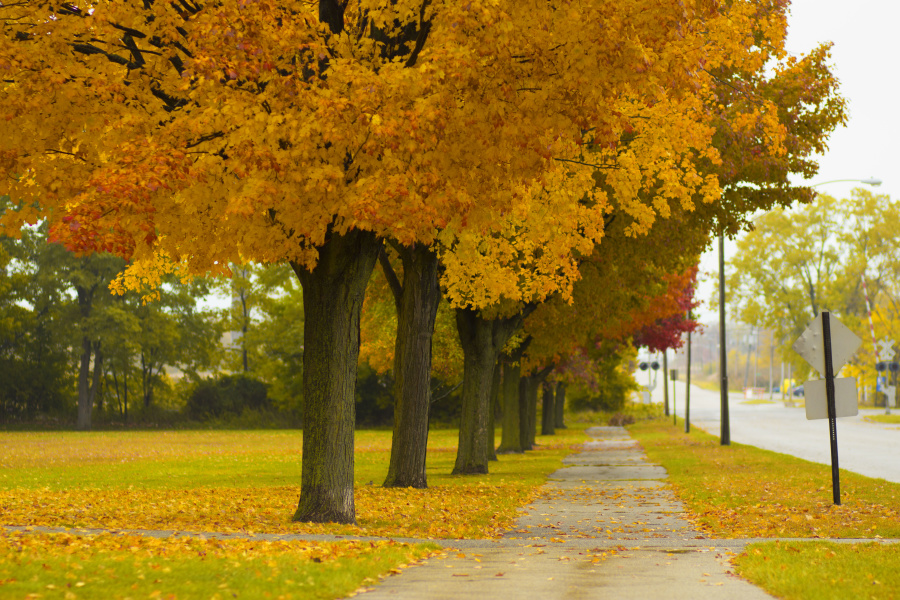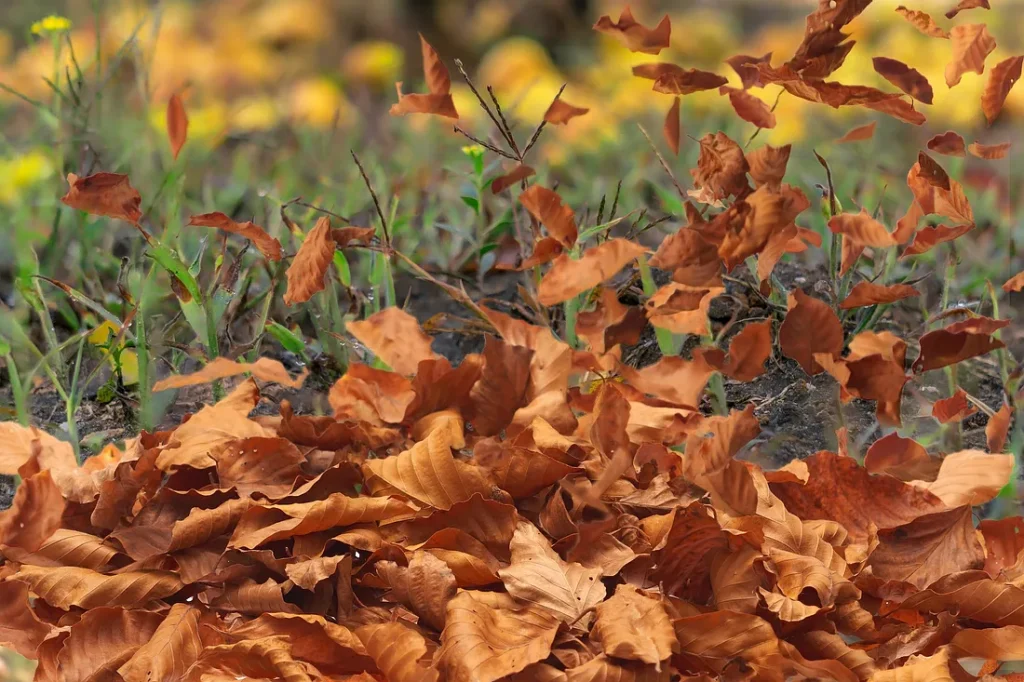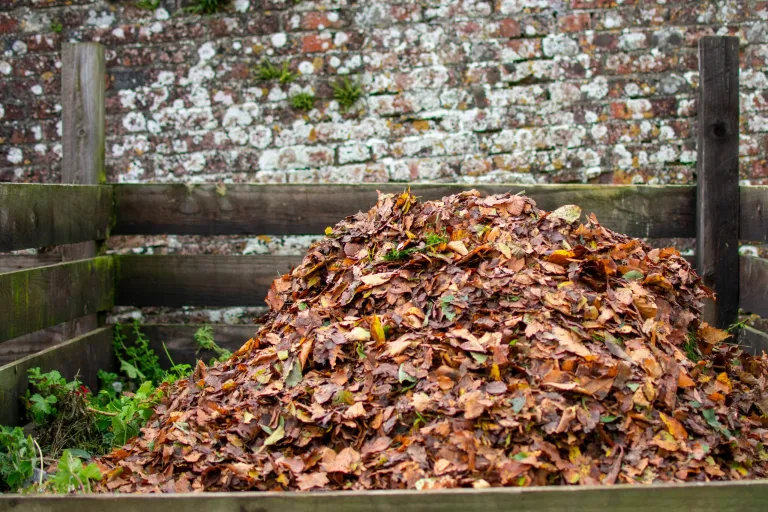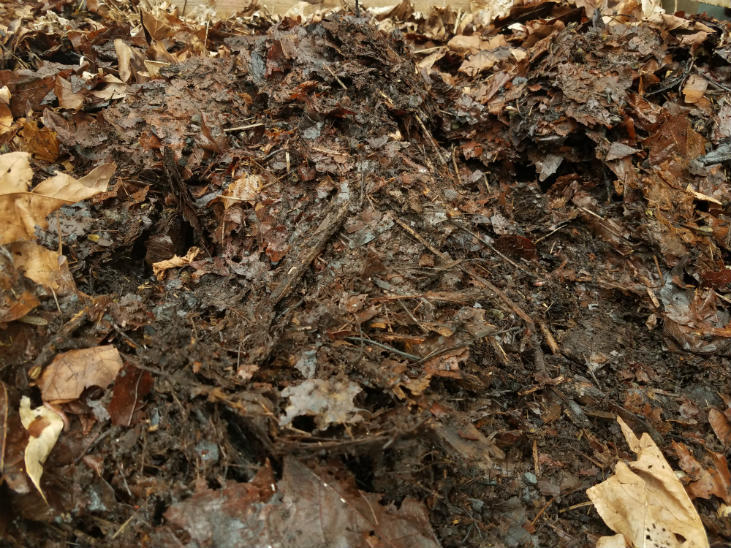From Colorful Canopy to Nutrient Haven
Autumn brings a flurry of colors, transforming the trees into fiery canvases of red, orange, and yellow, leaving a beautiful mess of leaves beneath. This colorful cascade is not just a treat for the eyes, but a secret ingredient to create a lush and healthy environment for our trees, turning our gardens and forests into thriving habitats.

The Unity of Leaves, Trees, and Leaf Mold
Each fallen leaf, while not densely packed with nutrients, does harbor essential elements like nitrogen, potassium, and phosphorus in trace amounts. As these leaves break down, they morph into leaf mold compost, a superior soil conditioner rich in fertility and abundant with microbial life. While the nutrient content in each leaf is relatively minimal, the process of decomposition allows the gradual release of these nutrients, contributing to soil fertility over time. Leaf mold is paramount in improving soil structure and its ability to retain water, creating a well-balanced, moisture-preserving environment. By reincorporating decomposed leaves or leaf mold into the soil, we are going beyond mere waste disposal; we are playing an active role in revitalizing the soil, turning it into a nourishing habitat where trees can establish strong roots, flourish, and uphold the delicate ecological balance of our planet.

Building a Lush Ecosystem
Step 1: Collecting and Breaking Down
Starting the journey towards creating rich, nourishing soil begins with the collection of healthy, disease-free leaves. It’s crucial to select leaves that show no signs of disease or infection to ensure the integrity and health of the subsequent compost and, eventually, the soil. Once you’ve collected a sufficient amount of leaves, the next step is to break them down into smaller pieces. This can be done using a lawn mower, leaf shredder, or even by hand if neither is available. Breaking down the leaves increases the surface area that microorganisms can work on, thus accelerating the decomposition process. This decomposition is pivotal as it transforms the leaves into a nutrient-rich, organic matter or ‘food source’ for our trees, helping them to grow stronger and healthier, and contributing to the overall vibrancy and balance of our environment.
Step 2: Balanced Composting
Embarking on the composting phase requires a balanced blend of the shredded leaves and green plant material, introduced together within a compost bin or a designated composting area. The green plant material can include items such as grass clippings, fruit and vegetable scraps, or fresh yard waste. Achieving the right equilibrium between ‘greens’ (nitrogen-rich) and ‘browns’ (carbon-rich) is crucial for the success of the composting process. Generally, a ratio of three parts browns to one part greens is recommended.

Ensuring the compost pile maintains adequate moisture is equally vital; the pile should have the dampness of a wrung-out sponge. A dry compost pile will decompose very slowly, while an overly wet pile may produce unpleasant odors. Regular turning or mixing of the compost pile is also necessary to incorporate oxygen, a critical element aiding in the decomposition process, facilitating the breakdown of organic matter into rich, fertile compost.
By diligently managing these elements, the composite materials metamorphosize into a nutrient-dense, soil-enhancing substance, which serves as an excellent conditioner, improving soil structure, water retention, and providing essential nutrients to plants and trees, subsequently promoting healthier and more resilient ecosystems.
Step 3: Protective Mulching
Once the collected leaves have reached a state of partial decomposition, it’s time to disperse them thoughtfully around the base of the trees. This layer of partially decomposed leaves serves a multifunctional purpose, acting as an organic mulch. Mulch is exceptionally beneficial to soil health and plant growth, it suppresses the growth of unwanted weeds, which would otherwise compete with the trees for essential nutrients and water. Additionally, it helps in retaining soil moisture by reducing water evaporation, ensuring that the trees have a consistent water supply, especially during the hotter and dryer periods.
Moreover, this layer of organic material continues its decomposition process, slowly releasing nutrients back into the soil, thus continually enriching it. This process of nutrient cycling is vital for maintaining soil fertility and promotes the vitality and longevity of the trees. By incorporating this practice, we aid in fostering a conducive environment for trees to thrive, enhancing the ecological balance and vibrancy of our landscapes.
Step 4: Enriching the Soil
Once the decomposition process reaches completion and the leaves have transformed into a rich, organic substance, it’s time to integrate this valuable material with the existing soil. This is a critical step in enhancing the overall quality and fertility of the soil, as this organic matter is loaded with essential nutrients and beneficial microorganisms that enrich the soil, improving its structure, water retention, and nutrient supply.
By meticulously mixing the fully decomposed leaves—now a premium, nutrient-rich compost—into the soil, you are effectively elevating the fertility levels of the soil, providing a conducive environment for robust tree growth. This infusion of organic matter revitalizes the soil, ensuring it becomes a thriving, nourishing hub where trees can anchor their roots, access ample nutrients, and flourish. This enriched, well-balanced soil becomes the cornerstone for healthy, vibrant trees, allowing them to thrive and contribute to the holistic well-being of our ecosystems. In turn, the trees play their pivotal roles in sustaining life, maintaining ecological balance, and beautifying our landscapes with their majestic presence.
Practical Tips for Soil and Tree Health
Maintaining Compost Balance
Maintaining a well-balanced compost is paramount for optimal tree health. An imbalance between green (nitrogen-rich) and brown (carbon-rich) materials can adversely affect the nutritional harmony crucial for robust trees. Strive for a composition that is well-proportioned, usually a 3:1 ratio of browns to greens, to foster a conducive environment for microbial activity and effective decomposition, ensuring a rich, nutrient-filled end product.

Careful Compost Management
Vigilant oversight of the compost’s moisture and thermal states is imperative. Regularly inspect your compost pile to ensure it retains sufficient moisture– it should feel like a wrung-out sponge. Equally crucial is the periodic turning or mixing of the compost to introduce oxygen, which aids in preventing anaerobic conditions and facilitates uniform decomposition, ensuring that the resultant compost is rich, balanced, and healthful for tree nourishment.
Precise Mulching
Proper mulching technique is crucial for tree well-being. When applying mulch, avoid piling it against the tree trunk as this can create a habitat for pests and diseases. Strive for a uniform spread around the tree, maintaining a clear, mulch-free space around the trunk to allow it to breathe and prevent rot. This ensures that the mulch can efficiently retain soil moisture and suppress weeds without compromising the health of the tree.
Regular Soil Checks
Conducting regular soil tests is essential to monitor its nutrient composition and pH levels. Knowledge of the soil’s condition allows for informed decisions regarding the application of leaf compost, enabling adjustments to be made to maintain optimal soil health and fertility. Regular assessments and calibrated adjustments ensure that the soil remains in a state conducive to supporting vibrant, healthy tree growth, contributing to overall ecological balance and resilience.
Locating Leaves and Leaf Mold Compost Services
In the journey to cultivate enriched, fertile soils, sourcing leaves, and particularly leaf mold compost, is a foundational step. For those who don’t have access to a plethora of falling leaves in their own yards, there are alternative solutions available. Many towns and cities offer services or locations where residents can acquire leaves or even pre-made leaf mold compost. These services are particularly valuable for individuals keen on embracing organic and sustainable gardening practices, aiding in the creation of vibrant, resilient ecosystems within their landscapes. Below are insights into how towns like Chapel Hill and Carrboro are contributing to such environmental endeavors by offering leaf and leaf compost to their residents.
Chapel Hill’s Eco-Friendly Leaf Delivery Service
In the environmentally-conscious community of Chapel Hill, a unique service is available to its residents, aimed at ecological conservation and effective utilization of leaves for soil enhancement. Residents have the opportunity to request deliveries of leaves for mulch or compost by contacting the Chapel Hill Public Works Department at 919-969-5100. The priority is given to the local residents, and deliveries are ideally kept within a one-mile radius of the town limits.
The leaf delivery is operated with utmost efficiency, focusing on areas where work crews are actively collecting leaves, rather than the order of requests. Potential recipients should be aware that each delivery will provide around 16 cubic yards of leaves, requiring careful consideration of its utilization since delivering partial loads is not an option. Chapel Hill’s initiative is a testament to the town’s commitment to environmental sustainability and fostering healthy soil conditions, conducive to the growth of robust trees and plants.
Carrboro’s Organic Soil Enrichment Initiative
Adjacent to Chapel Hill, the town of Carrboro is also spearheading efforts to promote environmental sustainability by offering its residents access to free leaf compost. This leaf compost is a fertile organic amendment, acting as a fantastic soil conditioner, even though its nutrient content is too low for it to be considered a fertilizer.
Residents can avail themselves of this enriching organic matter at 7917 Old NC 86, accessible during daylight hours. Carrboro’s provision of leaf compost signifies a stride towards ecological harmony, emphasizing the role of organic amendments in establishing healthy, balanced soils that support thriving plant and tree life. By doing so, Carrboro reinforces the shared vision for sustainable living and environmental consciousness within the community.
The Lasting Impact of Autumn’s Nutrient Treasure
Using the fallen leaves of autumn is like playing a symphony with nature, a harmonious dance of giving and receiving, nourishing and growing. It’s more than growing healthy trees; it’s about taking responsibility for the earth and nurturing the rich diversity of life it hosts. By tapping into the potential of autumn leaves, we create a living, breathing world where each tree is a symbol of vitality and balance.


Leave a Reply